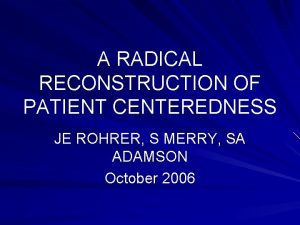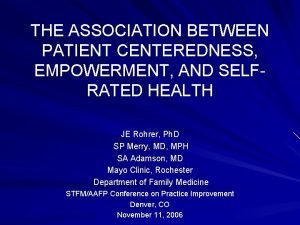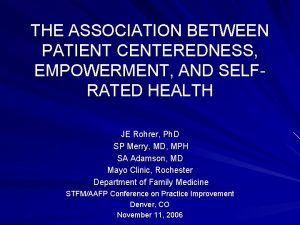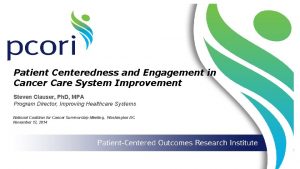A RADICAL RECONSTRUCTION OF PATIENT CENTEREDNESS JE ROHRER












- Slides: 12

A RADICAL RECONSTRUCTION OF PATIENT CENTEREDNESS JE ROHRER, S MERRY, SA ADAMSON October 2006

DEFINITION OF QUALITY VARIES BY LEVEL DONABEDIAN

MOVING BEYOND PATIENT CENTERED COMMUNICATION TO PATIENT CENTERED CARE 1. MD does what he thinks is best for the pt taking into account pt concerns (clinical outcome measures) 2. MD adopts the pts goals (self-rated health, patient satisfaction, self-efficacy) 3. Team adopts the pt’s goals 4. Care system addresses pts in groups outside of the clinic, pursuing the goals of the typical person

Objectives Patient centered communication (PCC) is often employed as a strategy for empowering patients. Is it the best approach? The purpose of this study was to investigate the relationship between a direct measure of patient empowerment, feeling that one is in control of one’s own health (health confidence), and PCC.

Previous Research Medical skepticism vs self-efficacy vs health confidence Not previously used as a measure of empowerment Validity of single question to measure health status is amply supported by prospective studies

Methods A cross-sectional phone survey of family medicine patients treated in Mayo Clinic in Rochester, Minnesota (N=800) Convenience sample, <40% response Tested theory that health confidence is related to satisfaction with several aspects of communication after adjusting for health status, age, and gender.

Specific Questions Asked SRH--In general, how would you rate your overall health? Confidence--In general, how would you rate your ability to take care of your own health without the help of a medical professional?

Descriptive Statistics (21% had high health confidence, N=800) Variable % % with High Confidence Good SRH Female Age category 18 -49 50 -64 65 -75 75 and over 53. 8 62. 6 29. 5 22. 3 41. 3 25. 9 16. 6 16. 2 26. 9 15. 9 18. 0 16. 9 p-value . 0000. 2198. 0066

Results Being highly satisfied with overall communication, explanations, listening, use of understandable words, and involvement in decisions were positively associated with health confidence. Self-rated health was more strongly related to health confidence than satisfaction with communication in every model tested (AORs ranged from 3. 0 -3. 15).

Six Multiple Logistic Regression Models of High Health Confidence Ratings Of care as % in sample “excellent” Overall quality 52. 7 Communication 59. 6 Explanations 58. 1 Listening 62. 6 Words 62. 5 Decisions 57. 5 % High Confidence p Odds Ratio* (Conf Int) 26. 2 25. 8 28. 4 26. 2 26. 8 . 0001. 0000 1. 83 (1. 3 -2. 6) 1. 89 (1. 3 -2. 8) 1. 97 (1. 3 -2. 9) 2. 29 (1. 5 -3. 5) 2. 20 (1. 5 -3. 3) 2. 26 (1. 5 -3. 4) *adjusted for age category, gender, and self-rated health

Conclusion Reliance solely on patient centered communication to promote empowerment may be insufficient. Also need to promote better self-rated health (health promotion)

Practice Implications Suggested empowerment strategies: 1) promotion of PCC behaviors (specifically explanations, listening, using understandable language and involving patients in decision-making) 2) health promotion programs delivered to patient groups, sometimes by non-MDs
 Angelettere
Angelettere Audience centeredness
Audience centeredness Audience centeredness
Audience centeredness Presidential and radical reconstruction venn diagram
Presidential and radical reconstruction venn diagram Radical republicans plan for reconstruction
Radical republicans plan for reconstruction Presidential and radical reconstruction venn diagram
Presidential and radical reconstruction venn diagram Radical reconstruction begins
Radical reconstruction begins Entire radical examples
Entire radical examples How to write an entire radical
How to write an entire radical Unit 6 test radical functions
Unit 6 test radical functions Patient 2 patient
Patient 2 patient Reconstruction clinton county
Reconstruction clinton county Confederate states
Confederate states























